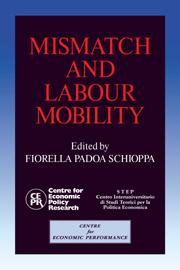Book contents
- Frontmatter
- Contents
- List of figures
- List of tables
- Preface
- Acknowledgements
- List of conference participants
- 1 A cross-country comparison of sectoral mismatch in the 1980s
- 2 Mismatch: a framework for thought
- Discussion
- 3 Match and mismatch on the German labour market
- Discussion
- 4 Mismatch in Japan
- Discussion
- 5 Mismatch and internal migration in Spain, 1962–86
- Discussion
- 6 Regional inequalities, migration and mismatch in Italy, 1960–86
- Discussion
- 7 Skill shortages and structural unemployment in Britain: a (mis)matching approach
- Discussion
- 8 Labour market tightness and the mismatch between demand and supply of less-educated young men in the United States in the 1980s
- Discussion
- 9 Skill mismatch, training systems and equilibrium unemployment: a comparative institutional analysis
- Discussion
- 10 Unemployment, vacancies and labour market programmes: Swedish evidence
- Discussion
- 11 Mismatch and labour mobility: some final remarks
- Index
Discussion
Published online by Cambridge University Press: 05 October 2010
- Frontmatter
- Contents
- List of figures
- List of tables
- Preface
- Acknowledgements
- List of conference participants
- 1 A cross-country comparison of sectoral mismatch in the 1980s
- 2 Mismatch: a framework for thought
- Discussion
- 3 Match and mismatch on the German labour market
- Discussion
- 4 Mismatch in Japan
- Discussion
- 5 Mismatch and internal migration in Spain, 1962–86
- Discussion
- 6 Regional inequalities, migration and mismatch in Italy, 1960–86
- Discussion
- 7 Skill shortages and structural unemployment in Britain: a (mis)matching approach
- Discussion
- 8 Labour market tightness and the mismatch between demand and supply of less-educated young men in the United States in the 1980s
- Discussion
- 9 Skill mismatch, training systems and equilibrium unemployment: a comparative institutional analysis
- Discussion
- 10 Unemployment, vacancies and labour market programmes: Swedish evidence
- Discussion
- 11 Mismatch and labour mobility: some final remarks
- Index
Summary
I find this informative study quite refreshing, because it does not attempt to give decisive answers to extremely complex questions. The study would have been better, however, if some questions (however complex) had been more clearly posed. The authors choose instead to state at various points what is not their purpose: not to address normative issues, not even to provide a positive interpretation of an impressive amount of information in terms of economic models, but simply to describe some facts. These comments summarise what the study does accomplish, focusing on some particularly striking features of the data which would indeed deserve a more careful analysis, and speculate briefly on how more formal structural work – admittedly outside of the scope of the study – might help interpret these features.
The study provides a huge mass of information. The authors, their research assistants, and their sources deserve a lot of credit for their hard work: perusal of the Data Appendix reveals that virtually none of the reported data series actually exist as such. The thorough description of the Italian internal migration phenomenon is more interesting to foreigners than to this discussant; it is extremely important for researchers to be acquainted with the complex internal dynamics of countries different from their own. A careful analysis of internal heterogeneity, of the economic phenomena triggered by regional disparities, and of the various (more or less successful) intervention policies will hopefully make it possible to achieve a smooth transition towards Europewide economic integration.
- Type
- Chapter
- Information
- Mismatch and Labour Mobility , pp. 321 - 324Publisher: Cambridge University PressPrint publication year: 1991



